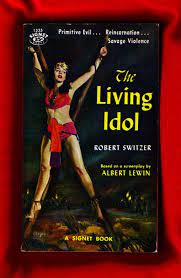
Archaeologist Doctor Alfred Stoner (James Robertson Justice) takes Reporter Terry Matthews (Steve Forrest) and the young Juanita (Liliane Montevecchi) up into a Mayan pyramid in the Mexican Yucatan. He wants to show them something special. Inside a small room is a stone idol in the shape of a jaguar. Upon seeing the stone idol Juanita has a visceral reaction. She flees from the pyramid and rushes to her father, and Stoner’s associate, Manuel (Eduardo Noriega). Stoner tells Manuel that in the past maidens were sacrificed to the jaguar god. He thinks that Juanita’s reaction is a racial memory of these sacrifices. The natives believed there was a living god inside the stone idol.
The next night, at a local fiesta, is a man dressed as the jaguar god. Juanita’s reaction to the mask he wears causes Terry and Stoner to be concerned. Stoner especially believes that there is some ancient memory in Juanita and that her soul is in danger.
Juanita has been in love with Terry since she was eight. As she gets older so does Terry’s affection for the now young woman. Her father wants Terry to marry Juanita so that she’ll settle down. Unfortunately Terry is assigned to cover a story in Korea. Before he leaves, Juanita’s father Manuel dies when a giant ancient rock with the figure of a jaguar carved on it falls on him. Stoner and his wife Elena (Sara Garcia) take the orphaned Juanita in as their foster child.
They move to Mexico City where Stoner works as a professor at the university and Juanita attends as a student. While in Mexico City Stoner becomes obsessed with a jaguar that is at the local zoo. He comes to believe that the jaguar is the physical manifestation of the Mayan jaguar god. When Terry returns from Korea he and Juanita plan their marriage. Stoner’s reaction is subdued. He is running out of time. The jaguar god demands maidens in its sacrifices.
“The Living Idol” was released in 1957 and was directed by Albert Lewin. It is based on the novel of the same name written by Lewin. It was the last film he directed. It’s an American adventure horror film produced by MGM. The movie was filmed in Mexico and the Yucatan.
There is some great cinematography of Mayan ruins from the Yucatan peninsula. The Mayan ruins are the highlight of the film. It appears that the pyramid and its ruins in the movie is the Chichen Itza City complex. A massive step pyramid, known as El Castillo or Temple of Kukulcan, dominates the area. The city thrived from around 600 A.D. to the 1200s. The Maya civilization ran from 2600 BC to 900 AD. The Aztecs thrived from 1300 to around 1521. The movie refers to both the Mayan and the Aztec civilizations. Juanita is a descendent of Mayan natives and the ritual Stoner refers to where the virgin is staked out and painted blue is the Mayan ritual. The Mayans, Aztecs, and Inca all worshiped the jaguar in some form.
As for the movie, it’s Ok in some spots but drawn out in others. A little confusing sometimes. The only real action is at the end. It’s an hour and forty minutes that could have been done in a little over an hour.
The film has been compared to Val Lewton’s “Cat People” 1942 and “The Leopard Man” 1943 but not in a good way. What Val Lewton managed to suggest in his productions that is not so apparent here is the noir thriller aspect. Lewton’s films had a way of building tension that’s not evident here. Juanita looks more like a moody teenager rather than a Mayan vestal virgin re-experiencing a past life. Why Stoner felt that he had to go to such extreme lengths to “cure” her into regaining her soul is not satisfactorily expressed. The movie is rather lukewarm as far as thrillers go.
Steve Forrest was born William Forrest Andrews. He is one of Dana Andrews’ younger brothers.

